Chapter IX

All Aboard!
The seventy-two Haida arrested on Lyell Island in November of 1985 had definitely elevated the cause for the Moresby campaign, even if the objectives were somewhat different. As Haida Nation president Buddy Richardson stated at the time, “The Haida objectives are very simple and very clear. The first is to protect Gwaii Haanas [Islands of Wonder] in its natural state in perpetuity, the second is to bring about recognition and respect for Haida title to Gwaii Haanas.”
Both causes were still a long way from resolution in the year of the blockade, though the tide was about to turn. While the BC government was referring to the arrested Haida elders as common criminals, I sensed that this was not the sentiment across the country. Jack Webster had done an amazing job of keeping the blockade in the spotlight with daily footage on his 9:00 a.m. TV show. Although totally opposing the protest and supporting the loggers, Jack inadvertently made South Moresby a household name across Canada like never before.
I started contemplating ways we could show national support for the cause in a more public and dramatic fashion than letter-writing campaigns and petitions. The Canadian Nature Federation (CNF) was Canada’s largest conservation organization and the nation’s equivalent of the American National Audubon Society—basically, bird lovers. When I was soliciting images and contributors for the Islands at the Edge book, I had approached Wayne Campbell, who worked in ornithology at the Royal BC Museum. Not only had Wayne graciously contributed the chapter “Down on the Water,” but I recalled him telling me that birding was the number-one hobby in the world—much more popular than stamp, coin, butterfly or seashell collecting. South Moresby had a quarter of the nesting seabirds in the Canadian Pacific, which was one reason the international Pacific Seabird Group was the first organization to lend its support to our cause. It also had the highest eagle-nesting density in Canada and second-highest in the world. It suddenly struck me that we needed to enrol and engage the birders.
I met with Gregg Sheehy, the conservation director of the CNF, to discuss ways to involve their members in the Moresby campaign, at least more directly than sending letters to the editors of newspapers. On one of my lobby trips to Ottawa, Gregg happened to mention that Gary Clarke, president of the Tourism Industry Association of Canada, had suggested to him that the South Moresby campaigners should take a train across the country to support the cause. Gregg did not take the offhand comment as a serious proposal, but I did.
In most people’s minds, the railway was the link that first connected Canada and gave it a strong sense of national purpose and identity. Never mind the fact that it was built on the backs of Chinese coolie labour, using land obtained for almost nothing (or outright stolen) from the Indigenous people, and capital raised for the most part in Britain. It was a symbol of national unity, or as historian Daniel Francis wrote, “We know that the railway no longer holds this country together in fact, but we suspect it is the one thing that holds it together in our imagination.” I was now excited about the prospect and determined to organize a national train caravan to bring Canadians together on the Moresby issue.
As the founding director of the Islands Protection Society, I was not used to having my proposals so quickly and soundly rejected. “That’s crazy, Huck,” I was told when I took the idea back to BC. “What if nobody or only a few people show up? We’ll just look weak.”
“The government already thinks we’re weak,” I replied. “What have we got to lose?” My argument dissuaded no one from their position, so I decided to seek support elsewhere.
On a subsequent visit to Ottawa in December, I told Gregg Sheehy to start organizing the CNF troops—we were going to do the train trip. “I think it was a bit like you calling a bluff and putting me on the spot, which is probably a good way to influence people,” Gregg wrote to me decades later. He took the proposal to the CNF and with his considerable powers of persuasion, solicited the board’s approval and started mobilizing the various chapters of the CNF from St. John’s, Newfoundland, to Vancouver with a mass mailing. Unfortunately, this was in the days prior to the internet and social media, and Canada Post delayed the bulk mail so long that the train had already passed before most CNF members received their notifications.
At first there was no support in BC for my hare-brained idea, but that just prompted me to push it harder. But once the ball started moving with the CNF endorsement, others came to support the caravan. Paul George, director of the Western Canada Wilderness Committee (WCWC), had been pivotal in the Moresby campaign. Had he and photographer Richard Krieger not photo-documented Windy Bay and proposed it for a BC ecological reserve, it would have been the first place on Lyell Island to be logged. Paul got his entire WCWC media machine behind the caravan to ensure it had a big finish in Vancouver even if it had a weak start out East. Jeff Gibbs, one of the founders of Canada’s Environmental Youth Alliance, also mobilized his students in support of the train. They brought a youthful energy that would rock Vancouver for the grand finale.
We had no operating budget and certainly could not afford to rent an entire passenger train, so we advertised a schedule of stops across the country where supporters could board and ride a segment of the route, or join special events in major cities along the way in St. John’s, Moncton, Halifax, Montreal, Ottawa, Toronto, Winnipeg, Regina, Calgary, Edmonton and Vancouver. Only Gregg Sheehy and I would ride the train the entire distance from coast to coast. Anticipating how easily our small contingent could get swallowed up in the hustle and bustle of a whistle stop, I asked Vancouver artists and South Moresby supporters Evelyn Roth and Hannelore Evans to design a large eagle puppet for the caravan. They crafted a magnificent, theatrical piece—a giant eagle with a twenty-foot wingspan that could be quickly assembled, hoisted at every train stop and disassembled before moving on. The eagle always drew a crowd, making our contingent look larger than life. We now had a made-for-television-and-news-photos mascot to identify and promote our cause.
John Broadhead also raised the caravan’s profile by designing a beautiful button for supporters to wear that quickly found its way from train conductor caps to the suit lapels of government officials. The design on the button was a Canadian National train heading south to Lyell Island, bringing Canada symbolically to Gwaii Haanas and the site of the Haida blockades, under the watchful eye of Raven and a full moon.

John Broadhead designed this button for the Save South Moresby Caravan. It depicts the train heading for Lyell Island under the watchful eye of Raven. john broadhead photo
A Canadian National Railway conductor proudly wears the button supporting the train caravan cause. Gregg Sheehy photo


During the launch of the eagle kite at Signal Hill, Newfoundland, at the start of the Save South Moresby Caravan in the spring of 1986, an Atlantic gust caught the large fabric wings and nearly carried us west ahead of our train. Gregg Sheehy photo
It was a blustery day on March 4, 1986, when Gregg Sheehy and a handful of local supporters, including Canadian folk singer Valdy, joined me to first unfurl the eagle mascot atop Signal Hill National Historic Park in St. John’s, Newfoundland, to mark the start of our journey. A strong Atlantic wind caught the giant wings, nearly lifting us all off the ground and threatening to fly us west ahead of our train. Gregg said that had the CNF had more time to notify their members we would have seen much bigger crowds at the outset. Unfortunately, time was of the essence, for by the time we had garnered enough support for the idea, we were running dangerously close to the date the BC government’s Environment and Land Use planning team would make their final decision on the fate of South Moresby. We needed to demonstrate that this was no idle endeavour; it was, in fact, the largest environmental campaign in Canadian history.
One group that did take the train caravan very seriously was the logging industry—two forest industry representatives who were trying to turn every rally into a debate tailed us the entire way. Meeting with the Canadian Sealers Association in St. John’s, the Chainsaw Twins, as the two came to be lovingly known, told the sealers that Greenpeace was behind the Moresby campaign (which it never was) and that they should come out in force to ride us out of town (quite literally and ironically) “on a rail.” A global Greenpeace campaign had all but shut down Newfoundland’s sealing industry at that time, and tensions were strong. Nobody’s fools, the Newfoundland sealers did a little research of their own and came to our opening rally, not heckling and threatening the “goddamn environmentalists” but wearing caravan buttons in support of the cause.
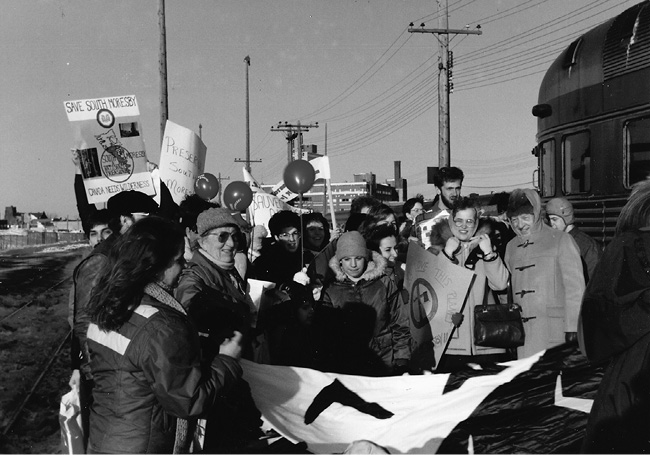
The Save South Moresby Caravan started out in Newfoundland where enthusiastic crowds cheered us on. There were no train links from St. John’s so we travelled aboard a CN Roadcruiser Bus. Gregg Sheehy photo
With no train links from St. John’s, the caravan had to start out aboard a CN Roadcruiser Bus. A CBC van riding beside us had a cameraman filming our passage from an open side door. He was hanging so far out with his heavy camera that Gregg and I feared he might fall and become the first casualty of the thirteen-year campaign.
Until 1969, when CN Rail curtailed all passenger train services in Newfoundland, rail travel had a real romantic appeal. Before roads were built across Newfoundland, the train’s dining car was said to have been the finest restaurant on the island as passengers chugged their way along North America’s longest narrow-gauge rails.

Supporters turned up out of nowhere in small and large groups as the Save South Moresby Choo Choo train caravan steamed across the world’s second-largest country. Gregg Sheehy photo
Once we did climb aboard the train in New Brunswick, I must confess to hearing echoes of some of the doubters back in BC when I went to bed in my sleeper car that first night. It was well past midnight when the train slowed for something or someone on the tracks; the slower clickety-clack sound of the rails beneath the carriage woke me. I lifted the blinds beside my bunk to groggily peer out. There, standing in knee-deep snow in the middle of the night, was a crowd of several dozen South Moresby supporters waving banners and balloons and wildly cheering us on. The train was running behind schedule, I learned later, and this group, members of the New Brunswick Federation of Naturalists, had been standing in the frigid cold for over an hour. I couldn’t believe my eyes, or their dedication, and I wondered how many other supporters we might have passed in the dark. Canadian nature lovers are a hardy lot, and from that moment on there was never a doubt in my mind that average Canadians were on board with this issue.

A bagpiper showed up to support the train arriving in Ottawa and escorted federal Environment Minister Tom McMillan as he boarded the ride to Toronto. Gregg Sheehy photo
Support came from the least likely places. An Air Canada pilot, Ernie Beauchesne, built a travelling display for our events and flew from city to city all the way to Vancouver to set it up ahead of the train’s arrival. The wife of a Canadian judge donated the $1,000 needed to rent St. Paul’s Anglican Church for the caravan’s event in Toronto. Bagpipers showed up at the CN Rail station in Ottawa to escort federal Environment Minister Tom McMillan onto the train wearing his VIA Rail hat with a Save South Moresby button attached. Even well-known celebrities like Pete Seeger, Bruce Cockburn and Long John Baldry lent their time and talents to fundraising events along the way.
Every day and at every stop more and more supporters came aboard. The Save South Moresby Caravan was becoming the party you didn’t want to miss. People boarded with musical instruments, composing lyrics and singing songs to the tune of “Chattanooga Choo Choo.” Revelling in the company of fellow Canadians united in purpose, supporters brought aboard food to share from their respective regions—maple syrup, bannock, smoked fish and Quebec’s contribution to low-fat diets, poutine: french fries smothered in gravy and grated cheese.
By the time the train reached Montreal, the press was following the story closely and members of Parliament were tripping over one another trying to get aboard the ride into Ottawa. Former prime minister Pierre Trudeau came out strongly in support of the caravan cause, as did Tom McMillan, House Speaker John Fraser and former Liberal environment minister Charles Caccia. It was snowballing and time for the Haida Nation to join in.
Our event in Toronto was scheduled for St. Paul’s Anglican Church and the Haida Nation flew in the elders arrested on Lyell Island four months earlier to be part of it. As the train pulled into Union Station, Guujaaw was on the platform pounding his drum along with a strong delegation of Haida in ceremonial blankets supporting their elders Ethel Jones, Ada Yovanovich, Watson Pryce and Grace Dewitt. They held big banners proclaiming, “You Can Kill a Tree but Not Haida Nation!” The church was packed that evening with an estimated seventeen hundred people as Pierre Berton, the esteemed Canadian historian, prepared to deliver a speech in support of the cause. He called the logging of South Moresby “an act of vandalism, a national disgrace.” Strong as his delivery was, it was not the highlight of the evening. That moment was reserved for the Haida elders’ entry.
The entire assembly rose in a spontaneous standing ovation as Nonnie Ethel Jones, Nonni Ada Yovanovich and Chini Watson Pryce (Chief Gaahlaay) walked down the centre aisle of the church to speak at the podium. Branded criminals by the BC government, these elders were getting a hero’s welcome in a major church in the nation’s financial capital. “It’s just wonderful how people across Canada are with us,” said Ethel Jones, who was scheduled to appear in court on April 16 in Prince Rupert to face charges and a possible jail sentence. “We know our fight is just beginning. We’re not stopping now,” she told the cheering church assembly.
It was one thing to bring environmentalists and bird lovers to the cause, but the elders had now brought the backing of church groups right across the country, making the movement so mainstream I knew there could be no turning back for the provincial and federal governments. In retrospect, the message must have been painfully clear for the authorities; you don’t arrest peaceful senior citizens holding their Bibles in front of national television cameras.
No environmentalist backroom planning session could have ever come up with such a strategy; it was pure serendipity or, as the Haida would see it, Raven working his mysterious ways. It seemed to me now just a matter of time and political willpower to seal the deal. Tom McMillan told me later that the Save South Moresby Caravan and the event in Toronto gave him the political clout he needed to prove to Ottawa and Victoria that this was truly a national issue.

Former federal environment minister Charles Caccia spoke at a train stop press conference in support of the Moresby campaign. Gregg Sheehy photo
Another major event in support of the train caravan and Moresby cause was held in Vancouver, organized by none other than Master Abstractor David Lawrence Phillips. He secured works from celebrated Canadian artists for a caravan support raffle and had Bob Rae at the piano and other well-known performers for a $100-a-plate fundraising dinner. What really grabbed the attention of the media was not the event, but the aftermath. Never one to waste good food and a lover of throwing spontaneous “beggar’s banquets,” David hired a food truck to transport all the leftovers to feed the city’s homeless. “Hundred-Dollar-a-Plate Dinners Served on Skid Row” the newspapers blared the next morning. The Moresby campaign was now reaching every segment of Canadian society.
As the Save South Moresby Choo Choo (as it came to be lovingly known) roared its way across the second-largest country on earth, excitement mounted. A huge First Nations powwow was held in Winnipeg in support of the Haida’s stand on Lyell Island and major events were held in Regina and Calgary before the train route split in Calgary so Edmonton could be included on the northern route. Gregg Sheehy rode with supporters on the southern route along with Colleen McCrory and famed bear biologist Charlie Russell, while I headed north with an excited throng of supporters to Edmonton for another big event. The train really filled up in Jasper for one of the world’s most scenic rail journeys through the Canadian Rockies all the way to Vancouver.
The Save South Moresby Caravan Supercontinental #3 train pulled into Vancouver’s CN Rail station at 1:30 p.m., March 15. It was greeted by over two thousand cheering people crammed into the station and in front of the building as the caravan supporters disembarked from Edmonton. Calgary supporters, having arrived at 9:30 a.m., were already on the platform to welcome the second train. As Gregg Sheehy and I unfurled the giant eagle for the last time, we could only quietly smile at each other. From when we had first done this in St. John’s just ten days earlier, our numbers had swelled a thousandfold. The train caravan had become more than a success; it was a seminal event.
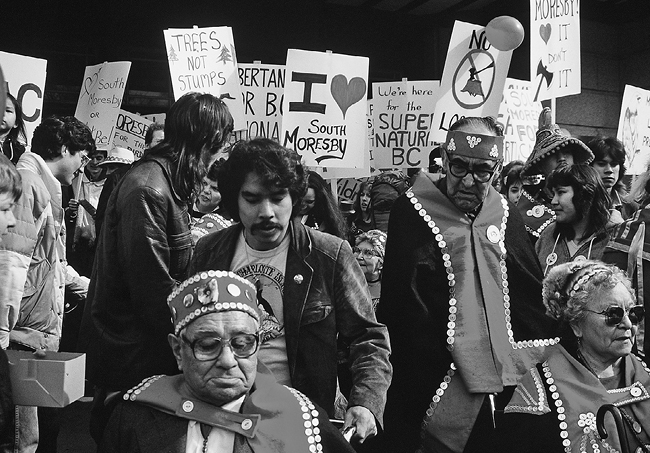
Haida elders who rode the train from Toronto to Vancouver are welcomed by banner-waving and cheering supporters at the journey’s end. Richard Krieger photo
After some preliminary speeches in front of the train station, a parade ensued through downtown Vancouver all the way to Burrard Inlet. The Western Canada Wilderness Committee had secured a parade permit from city hall so we could legally make our march. As Guujaaw drummed the elders through the streets, I hoisted the eagle kite at the front of the parade route. There was a festive air to the march; it was more than a protest, with red and white balloons dancing in the fresh spring breeze, heartfelt banners and homemade signs all following a giant eagle kite beneath which Haida in full regalia sang celebratory songs.
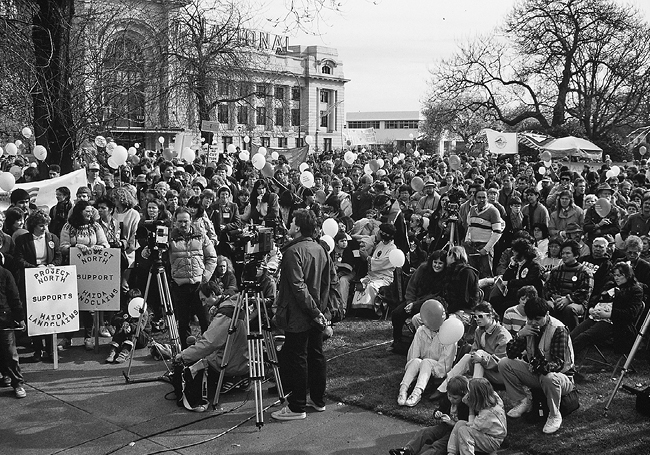
Thousands of supporters in front of the CN Rail station welcomed the train’s arrival in Vancouver. richard krieger photo
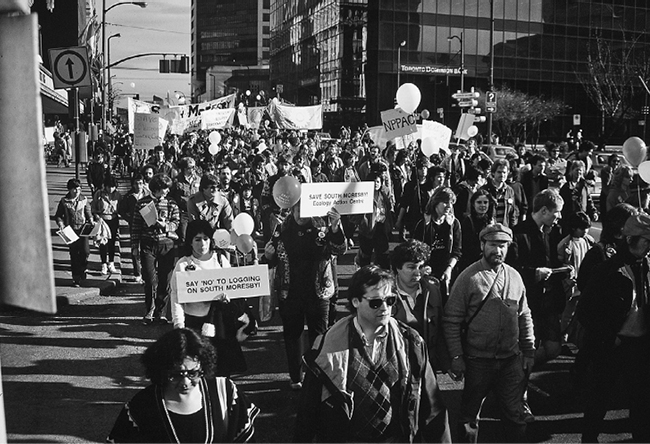
The Save South Moresby Caravan parade swelled in numbers as it proceeded from the CN Rail station to Canada Place on Burrard Inlet. richard krieger photo
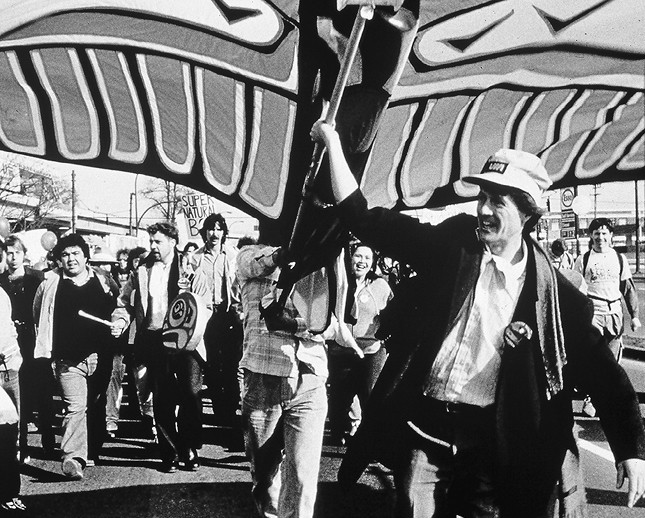
After leading the Vancouver parade with the eagle kite at the end of our historic train journey, I never saw our eagle mascot again. Richard Krieger photo
I don’t believe we ever got an estimate of the crowd size that continued to swell as we marched across the Cambie Street Bridge through downtown Vancouver to Burrard Inlet, but it was enormous by the time we reached Canada Place, the federal government’s newly built showcase for Expo 86. It seemed a fitting place to end a historic journey to raise awareness for the Moresby campaign and Haida rights. Expo 86 was, after all, scheduled to be a World Exposition on Transportation and Communication.
At the Canada Place rally, Buddy Richardson said it was a day of celebration, “celebrating South Moresby as an important part of the earth.” Jim Fulton, MP for the region and the person who introduced the guest speaker, noted that a bald eagle was circling the gathering. “It’s symbolic!” he said, and indeed it was. It seemed as if the eagle kite mascot that had just travelled with us seventy-five hundred kilometres across Canada had finally freed itself of its inanimate form, and true to the Haida tradition of transformation, it just sort of disappeared. I have no idea what happened to it after that event.
Some years later, Jim Hart, Chief Eidansuu (Edenshaw) from Old Massett, was telling me of a time he was carving near Masset Inlet and saw a raven land on a spruce branch near the water’s edge. “The poor thing had its beak stuck in a white Styrofoam fishing float,” Jim said. “I thought it would starve to death, but I had no idea how I could help it.” While he was pondering the dilemma, a flock of surf scoter ducks flew in to dabble along the water’s edge. Seeing them, the raven suddenly swooped down with outstretched wings and scattered them in all directions. The raven then returned to the same branch it had been sitting on, effortlessly threw off the fish float and cawed as if it were laughing. “That rascal was pretending to be an eagle,” Chief Edenshaw told me. “He could never have startled the ducks as a raven, but he scared the hell out of them with the white ‘head’ of a bald eagle.”
Perhaps the Save South Moresby Caravan’s eagle puppet was Raven in disguise all along.